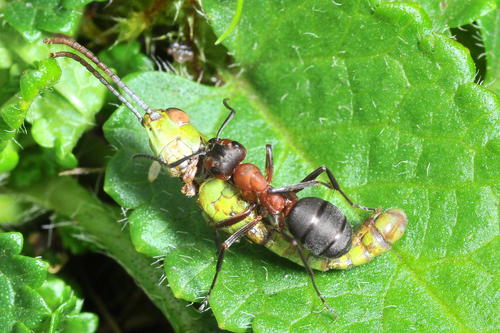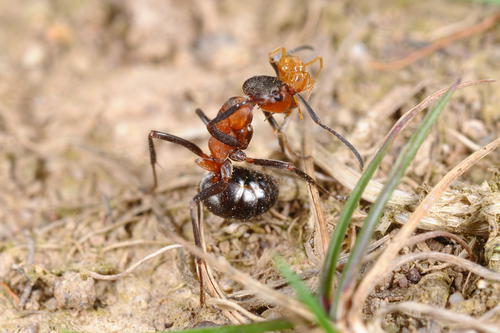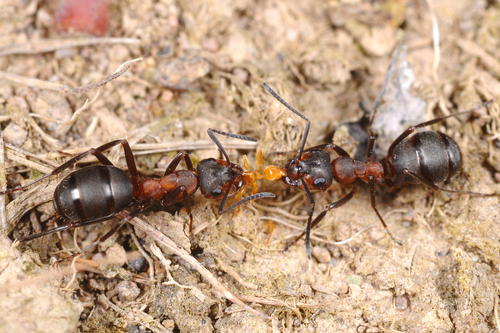Observations of Wood Ant Formica rufa activities in Wyre Forest
John Bingham
Wyre Forest is notably famous for the huge numbers of Wood Ants Formica rufa that it supports. It is impossible not to be intrigued by their activities and recent years have seen records of associated species such as the Scarce 7-spot Ladybird Coccinella magnifica and shinning guest ant Formicoxenus nitidulus.
Ants are often seen carrying prey items but I was fascinated to see one lone ant carrying away a freshly dead grasshopper many times its body size (Fig. 1.). The ant appeared almost excited by its find and I was surprised at the speed it made off with the prey. At one point during my attempts at photography I moved the grasshopper with the ant attached to a clear area. The ant lost its grip and was separated from the grasshopper. It started a random search pattern to relocate the prey and within seconds appeared to detect it, by scent first and then touch. It repeated this search every time it became separated, clearly putting effort into relocating the prey item. The extent of Wood Ants taking other invertebrates must have an impact on the forest invertebrate fauna, yet Wyre appears to be species rich. One wonders what it might be like if Wood Ants were rare, or do they actually enhance the forest fauna?
Normally Wood Ants are scavengers not predators but I observed Wood Ant killing Yellow Meadow Ants Lasius flavus along a ride in the forest. The dry weather had opened up cracks in the soil allowing Wood Ants access below ground. One Wood Ant trail crossed the ride and ants were descending into the cracks and reappearing in a searching frenzy. Occasionally a Wood Ant would emerge with a Meadow Ant attached to its leg or antenna, clearly annoyed by this the Wood Ant would try to remove the yellow ant and even arched its body to spray formic acid onto the Meadow Ant (Fig. 2.). At first I thought this activity was more coincidence but on closer study realised the Wood Ants were hunting Meadow Ants and apparently eating them, or at least killing them. Wood Ants would descend again and again into the cracked soil and sometimes flush out the Meadow Ant that would be hunted on the surface by other Wood Ants. On one occasion two Wood Ants were seen pulling apart a Meadow Ant (Fig. 3.). I can only assume that normally Meadow Ants are subterranean and not readily accessible to Wood Ants but the cracked ground had exposed the Meadow Ants underground passageways. Possibly the Wood Ants were lacking their usual prey items due to the dry weather. The match was one sided although the Meadow Ants were clearly fighting back and causing some distress or at least annoyance to the Wood Ant.
Images
Fig. 1. Wood Ant with grasshopper prey. ©John Bingham
Fig. 2. Wood Ant preying on Yellow Meadow ant. ©John Bingham.
Fig. 3. Wood Ant preying on Yellow Meadow ant. ©John Bingham


